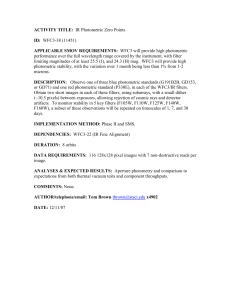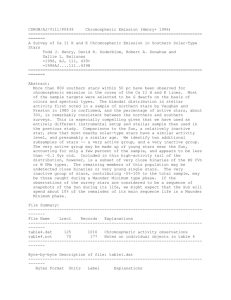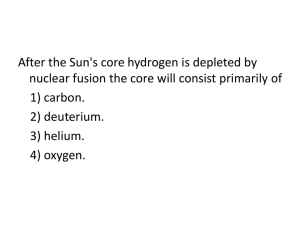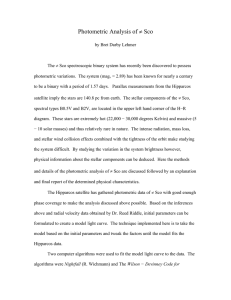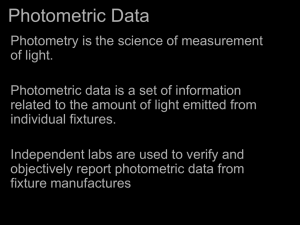Photometric System
advertisement
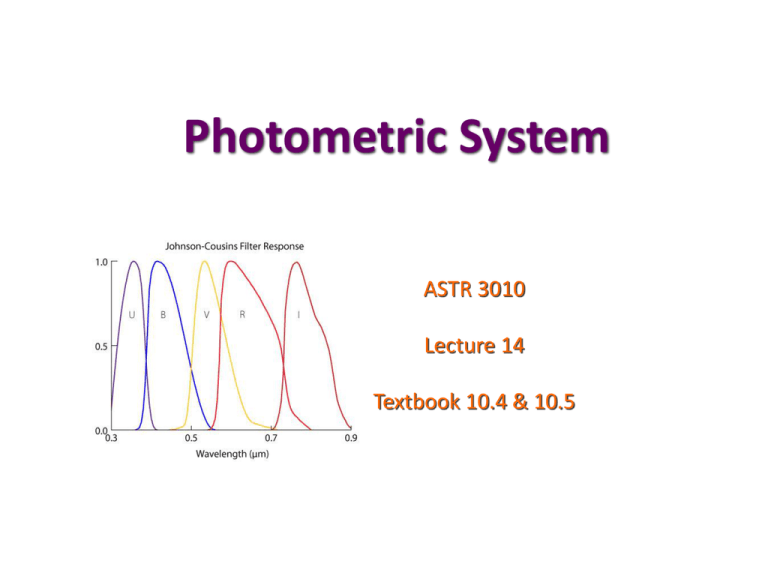
Photometric System ASTR 3010 Lecture 14 Textbook 10.4 & 10.5 Photometric System ( ) m p = -2.5log Fp + C p ¥ = -2.5log ò Rp ( l) f l dl + C p 0 • Narrow meaning : wavelength response of a band (Rp) instrumental magnitude • Broader meaning: a method for standardizing measurements made with a photometric band (i.e., with specific Rp and Cp) standard magnitude standardization How? Standardization: Can be done by using an object with known spectral shape. But, in practice, a set of “standard” stars are used Common photometric system • 100s of photometric systems so far • Excellent summary of photometric systems in Annual Review of Astronomy & Astrophysics by Mike Bessel (2005) • Visual and photographic systems o Visual (mvis) : naked human eye, peak λ ~ 530nm o International photographic (mpg) : photographic emulsion + atmosphere, peak λ ~ 400nm o International photovisual (mpv) : orthochromatic emulsion + yellow filter, peak λ ~ 550nm o 1922 IAU set the zero points (Cp) of both systems such that 6th mag A0V star should have the same magnitudes color index = mpg – mpv, 0 for A0V, negative for hotter, positive for cooler stars UBVRI system • Johnson-Cousins system : Most frequently used photometric system • UBV defined first by Johnson & Harris (1954) o RCA 1P21 photomultiplier + several colored glasses o V is similar to mpv o U-B and B-V zeros for A0V stars • Then, in 60s, R and I bands are added UBVRCIC system • Increased sensitivity at R-band and decreased red-edge for I-band UBVRI Bessell Filter System • Modern CCDs have difficulty replicating the original photomultiplier-based instrumental system wide variety of CCD spectral response • published a set of combinations of cheap optical glass filters for commonly used CCDs which would reproduce reasonably well the classic JohnsonCousins passbands UBVRI system UBVRI system color indices • • • • • U-B : Sensitive to Balmer Discontinuity luminosity B-V, V-R, R-I : sensitive to temperature spectral type B-V is more affected by metallicity than V-R and R-I B-V becomes useless for M-type stars (why?) V-I index is the most purely temperature sensitive index in UBVRI system (V-K) is even better! Why? A set of suggested standard stars : “Landolt Standards” need for fainter standard stars JHKLMNQ systems (1-20 microns) • “Broadband Infrared System” : an extension of the UVBRI into IR • Common zero point: colors of an A0V star are zero by definition • Bandpass definitions can depend critically on atmospheric conditions (mainly water vapor) different observatories with identical hardware will measure differently same observatory will see a bandpass variation due to weather • In 2000, IAU recommended a new system (Mauna Kea Observatory) for JHK MKO near-IR system By narrowing the passband (i.e., decreasing FWHM) o Minimize sensitivity to water vapor o Maximize S/N • A set of standard stars : “Elias Standards”, but still evolving… Strömgren System (uvbyβ) • In 1950s, Strömgren defined intermediate band system • D. Crawford used it extensively to develop observing techniques in 60s/70s • uvbyβ (six filter system) o o o o (b-y) : temperature c1 = (u-v)-(v-b) : luminosity m1=(v-b)-(b-y) : metallicity β: better luminosity index for hot * better temp index for cooler * • For some reasons, uvbyβ is not being used that much nowadays… Sloan Digital Sky Survey system • A CCD sky survey which measured hundreds of millions objects. • Filters are designed to optimize the silicon CCD sensitivity. • May take over UBVRI system… SDSS usabilities Palomar Observatory Sky Survey (POSS) Others 30 filters 48 filters Various Color-Color Diagrams Various color-color diagrams are made to “isolate” interesting Group of stars Intrinsic colors of main sequence stars In summary… Important Concepts Important Terms • Photometric system • Color indices and physical parameters • Color of A0V star • • • • Photographic & photovisual mag Johnson-Cousin system Bessel system Broadband infraredbands Chapter/sections covered in this lecture : 10.4 & 10.5

